ChatGpt Guide for Product Managers: Use Cases and Top 101 Prompts in 2023
Chapter 1: Introduction
Product management is a complex and multifaceted role that requires a deep understanding of customer needs, market trends, and business goals. As the product manager, it is your responsibility to guide the development of a product from conception to launch and beyond, ensuring that it meets the needs of your target audience and delivers value to your business.
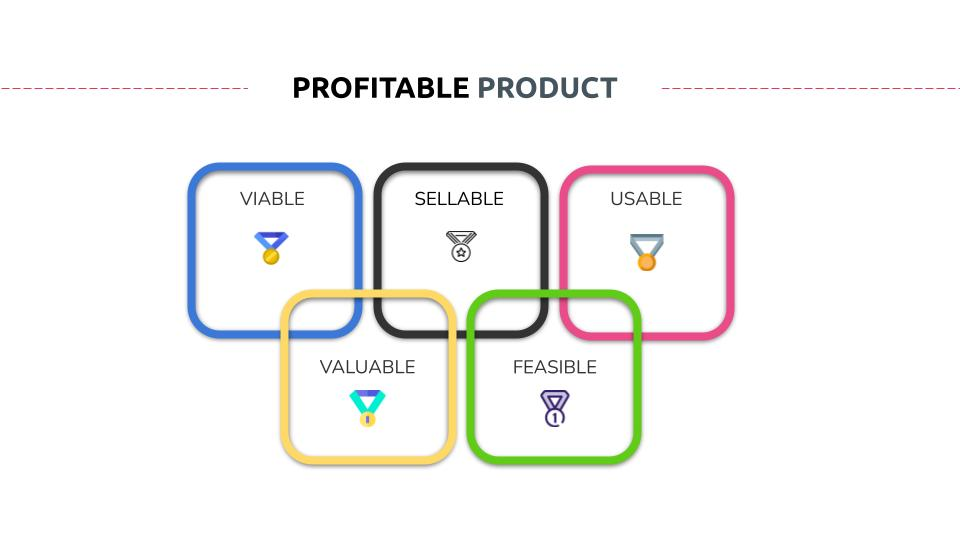
Image: Profitable Product Concept on EpiProdux.com
In recent years, the rise of artificial intelligence (AI) has introduced new tools and technologies that can support product managers in their work. One such tool is ChatGpt, a large language model trained by OpenAI that is capable of generating human-like text based on a given prompt.
ChatGpt can be used in a variety of ways in product management, from generating new product ideas to automating customer support interactions. By leveraging the power of AI, product managers can streamline their workflow and gain valuable insights into customer needs and trends.
The purpose of this article is to provide product managers with a comprehensive guide to using ChatGpt in their work. We will explore various use cases for ChatGpt in product management, provide prompts for generating text with ChatGpt, and offer best practices for using ChatGpt effectively.
Whether you are a seasoned product manager looking to streamline your workflow or a newcomer to the field, this guide will help you leverage the power of AI to drive product success. So let’s dive in and explore the exciting possibilities of ChatGpt in product management.
Chapter 2: Use Cases for ChatGpt in Product Management
ChatGpt can be a powerful tool for product managers, providing insights and generating text that can inform various aspects of product development. In this chapter, we will explore some of the most common use cases for ChatGpt in product management.
Market Research
One of the most powerful applications of ChatGpt in product management is market research. ChatGpt can analyze customer feedback and social media posts to identify trends and pain points that can inform product development. By training ChatGpt on your specific industry and product, you can gain valuable insights into what your target audience is looking for and what problems they are trying to solve.
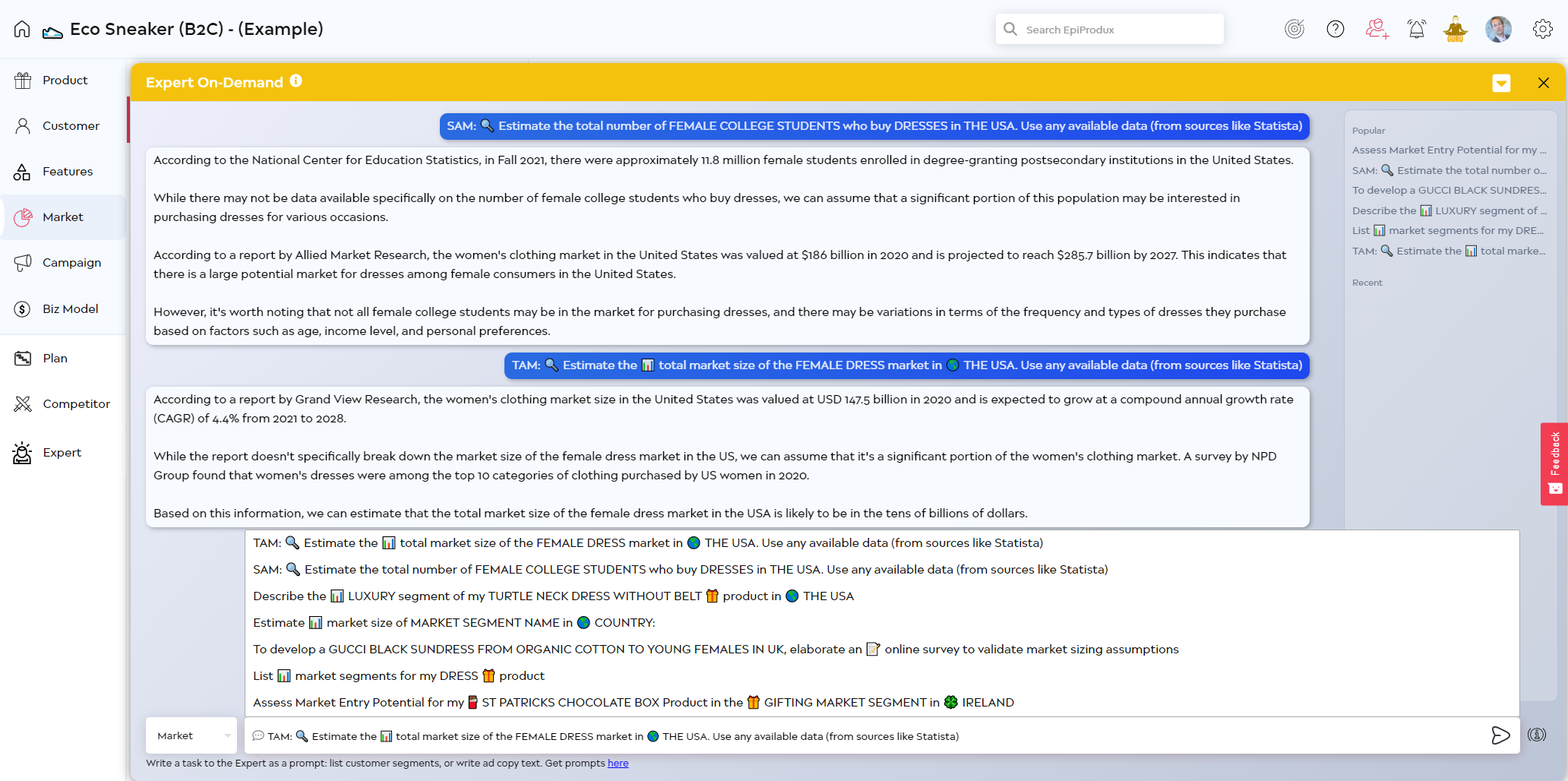
Image: Market research with ChatGPT and EpiProdux.com
Idea Generation
Product managers are constantly seeking new product ideas that will resonate with their target audience. ChatGpt can be used to brainstorm new ideas based on current customer trends or to generate entirely new concepts. By providing a prompt that describes the needs and pain points of your target audience, ChatGpt can generate ideas that you may not have thought of otherwise. Generating product ideas which are unique, providing competitive advantage to business, generate more profits in product-lead growth.
Content Creation
ChatGpt can also be used to generate content for various aspects of product development, including marketing copy and product descriptions. By providing a prompt that describes the key features and benefits of your product, ChatGpt can generate compelling text that highlights its unique selling points.
Customer Support
ChatGpt can also be used to automate customer support interactions, such as responding to frequently asked questions or handling basic troubleshooting. By training ChatGpt on your product and customer support guidelines, you can provide fast and efficient support to your customers while freeing up your support team to handle more complex issues.
Competitive Analysis
Finally, ChatGpt can be used to analyze competitor messaging and strategy. By providing a prompt that describes your competitors’ key messages and strategies, ChatGpt can identify areas where your product can differentiate itself and provide unique value to your target audience.
In the next chapter, we will provide prompts that product managers can use to generate text with ChatGpt in these various use cases. By leveraging these prompts and the power of ChatGpt, product managers can streamline their workflow and gain valuable insights into customer needs and trends.
Chapter 3: Prompts for Using ChatGpt in Product Management
In the previous chapter, we explored various use cases for ChatGpt in product management, including market research, idea generation, content creation, customer support, and competitive analysis. In this chapter, we will provide specific prompts that product managers can use to generate text with ChatGpt in these various use cases.
Market Research
- “What are the most common complaints customers have about our product?”
- “What are the top three features customers are looking for in products like ours?”
- “What are the most common trends in our industry right now?”
- “What are emerging customer behavior in my market”
Idea Generation
- “Generate five new product ideas based on current customer trends.”
- “Brainstorm ideas for how we can improve our product’s user experience.”
- “Generate product ideas for modular houses.”
- “Come up with three product ideas that solve a pain point in our target audience’s daily life.”
Content Creation
- “Write a product description that emphasizes our product’s unique features.”
- “Generate marketing copy that highlights our product’s benefits to our target audience.”
- “Create a social media post that showcases our product’s unique selling point.”
Customer Support
- “Automate responses to common customer support inquiries using ChatGpt.”
- “Generate a troubleshooting guide for common issues customers experience with our product.”
- “Create an FAQ page for our website using ChatGpt-generated content.”
Business Model Creation
ChatGPT can be a helpful tool in the creation of a business model using the Business Model Canvas (BMC) by generating text that can inform various sections of the canvas. By using ChatGPT in the creation of a business model using the BMC, businesses can gain valuable insights and generate text that can inform various sections of the model. However, it is important to keep in mind the limitations of ChatGPT and to review and refine the generated text to ensure accuracy and quality. Ultimately, the business model should be based on a combination of data, insights, and expert analysis from EpiProdux.com and ChatGPT can be a helpful tool in this process.
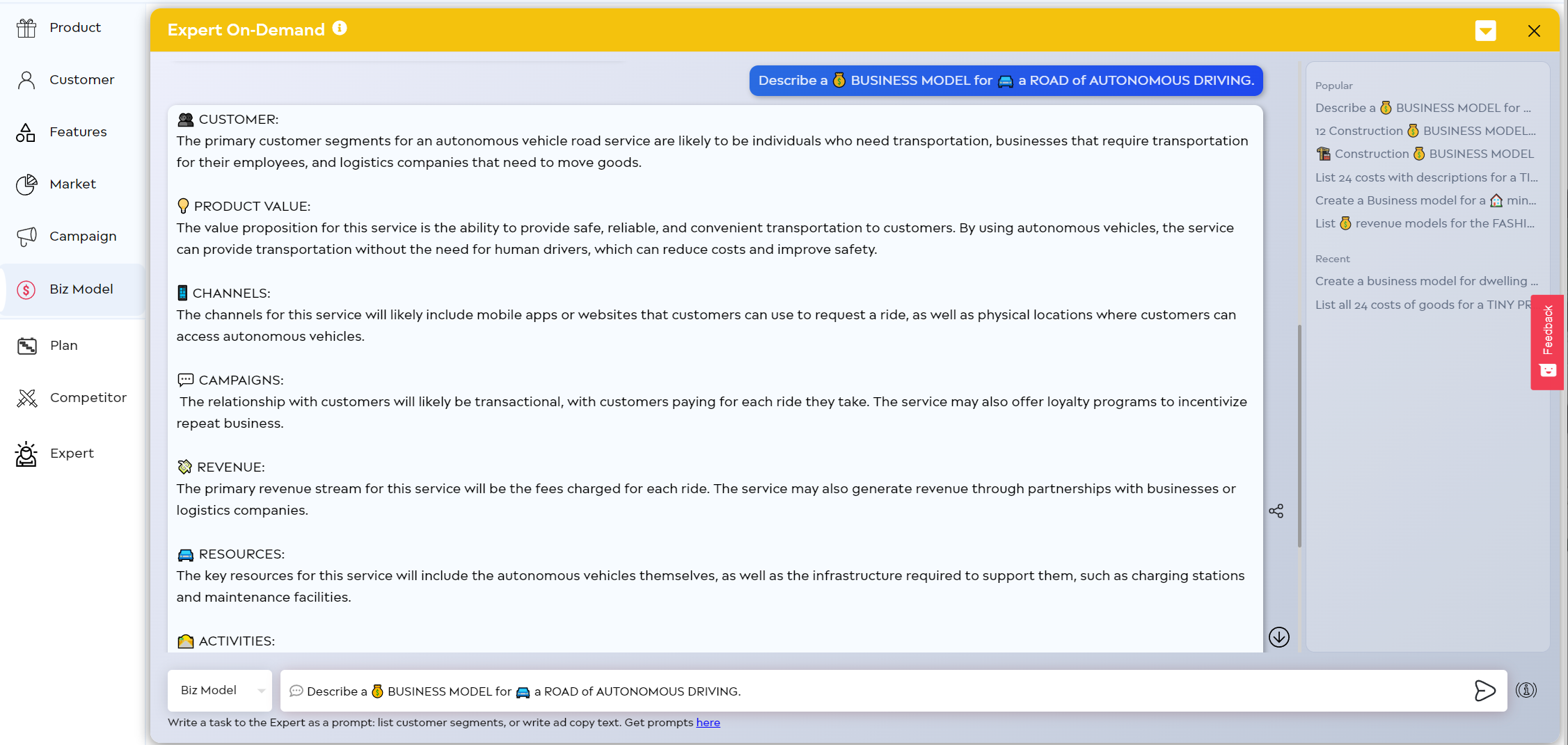
Image: Business Model creation using data, insights from EpiProdux.com and ChatGPT.
Competitive Analysis
- “Analyze our competitor’s messaging and identify areas where we can differentiate ourselves.”
- “Create a list of our competitor’s key features and benefits using ChatGpt.”
- “Generate text that describes how our product is unique compared to our competitors.”
By using these prompts with ChatGpt, product managers can generate text that is relevant and informative, providing valuable insights into customer needs and trends. However, it is important to keep in mind the limitations of ChatGpt and to review and refine the generated text to ensure accuracy and quality. In the next chapter, we will provide best practices for using ChatGpt effectively in product management.
Chapter 4: Best Practices for Using ChatGpt in Product Management
While ChatGpt can be a powerful tool for product managers, it is important to use it effectively and responsibly. In this chapter, we will provide some best practices for using ChatGpt in product management.
Understand the Limitations of ChatGpt
ChatGpt is a language model that is trained on a large corpus of text, but it is not perfect. It may generate text that is inaccurate, irrelevant, or even offensive. Product managers should be aware of these limitations and should not rely solely on ChatGpt-generated text.
Train ChatGpt on Your Specific Industry and Product
To improve the accuracy and relevance of ChatGpt-generated text, product managers should train ChatGpt on their specific industry and product. By providing relevant training data and prompts, product managers can ensure that ChatGpt generates text that is relevant and useful.
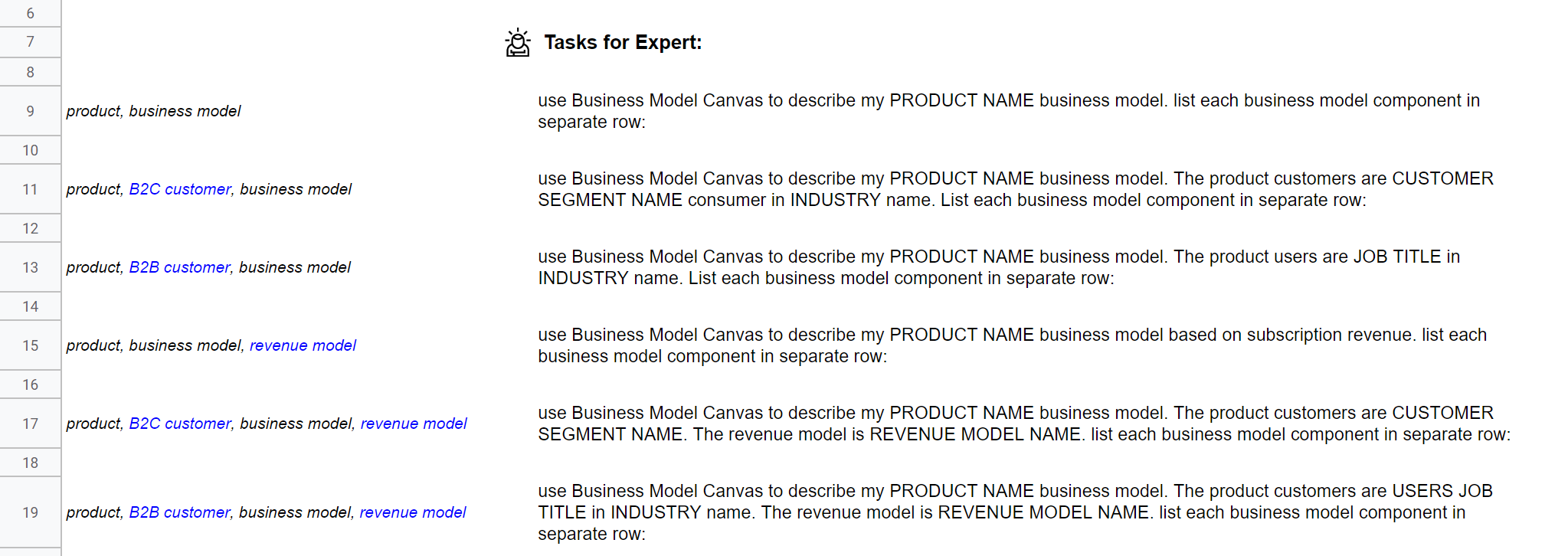
Find 101 ChatGPT product management prompts for
different industries on Google Sheet here
Monitor and Review ChatGpt-Generated Content
Product managers should review and refine ChatGpt-generated content to ensure accuracy and quality. This can involve editing and revising the generated text, as well as verifying any factual information. Product managers should also ensure that the generated text is consistent with their brand voice and messaging.
Maintain Transparency with Customers
If product managers are using ChatGpt to automate customer support interactions, it is important to maintain transparency with customers. Customers should be informed that they are interacting with an AI chatbot and should be provided with clear instructions on how to escalate their inquiry if they require additional assistance.
By following these best practices, product managers can leverage the power of ChatGpt to streamline their workflow, gain valuable insights into customer needs and trends, and improve the overall success of their product. However, it is important to use ChatGpt responsibly and to always prioritize accuracy and quality.
Chapter 5: Creating Product Roadmaps with ChatGPT and EpiProdux
ChatGPT and EpiProdux.com can be used together to create product roadmaps by providing valuable insights and generating text that can inform various aspects of the roadmap. Here’s how:
Identify customer needs and pain points:
EpiProdux.com can provide market data and insights to product managers that can be used to identify customer needs and pain points. This information can be used as prompts for ChatGPT to generate text that describes the features and benefits of the product that will address these needs and pain points.
Define product features and milestones:
ChatGPT can be used to generate text that describes the specific features and milestones of the product roadmap based on the customer needs and pain points identified through market research. This information can be used to define the product vision, roadmap, and milestones.
Prioritize features and milestones:
EpiProdux.com can provide data on customer needs and market trends that can be used to prioritize the features and milestones of the product roadmap. ChatGPT can be used to generate text that describes the priority of each feature and milestone based on its potential impact on the target audience.
Define timelines and resources:
ChatGPT can be used to generate text that describes the specific timelines and resources required for each feature and milestone of the product roadmap. This information can be used to create a detailed plan for the development and launch of the product.

Image: Product roadmaps generated with ChatGPT and EpiProdux.com
By combining the market data and insights provided by EpiProdux.com with the natural language processing capabilities of ChatGPT, product managers can create comprehensive and effective product roadmaps that are based on customer needs and market trends. It is important to keep in mind the limitations of ChatGPT and to review and refine the generated text to ensure accuracy and quality. Ultimately, the product roadmap should be based on a combination of data, insights, and expert analysis.
Chapter 6: Productivity Boost by EpiProdux.com and ChatGPT Integration
ChatGPT and EpiProdux.com can work together to improve product managers’ productivity by providing a comprehensive suite of tools for product management. EpiProdux.com is a product management software that provides market data and provide valuable insights to product managers. ChatGPT, on the other hand, is an AI-powered tool that can generate text based on given prompts.
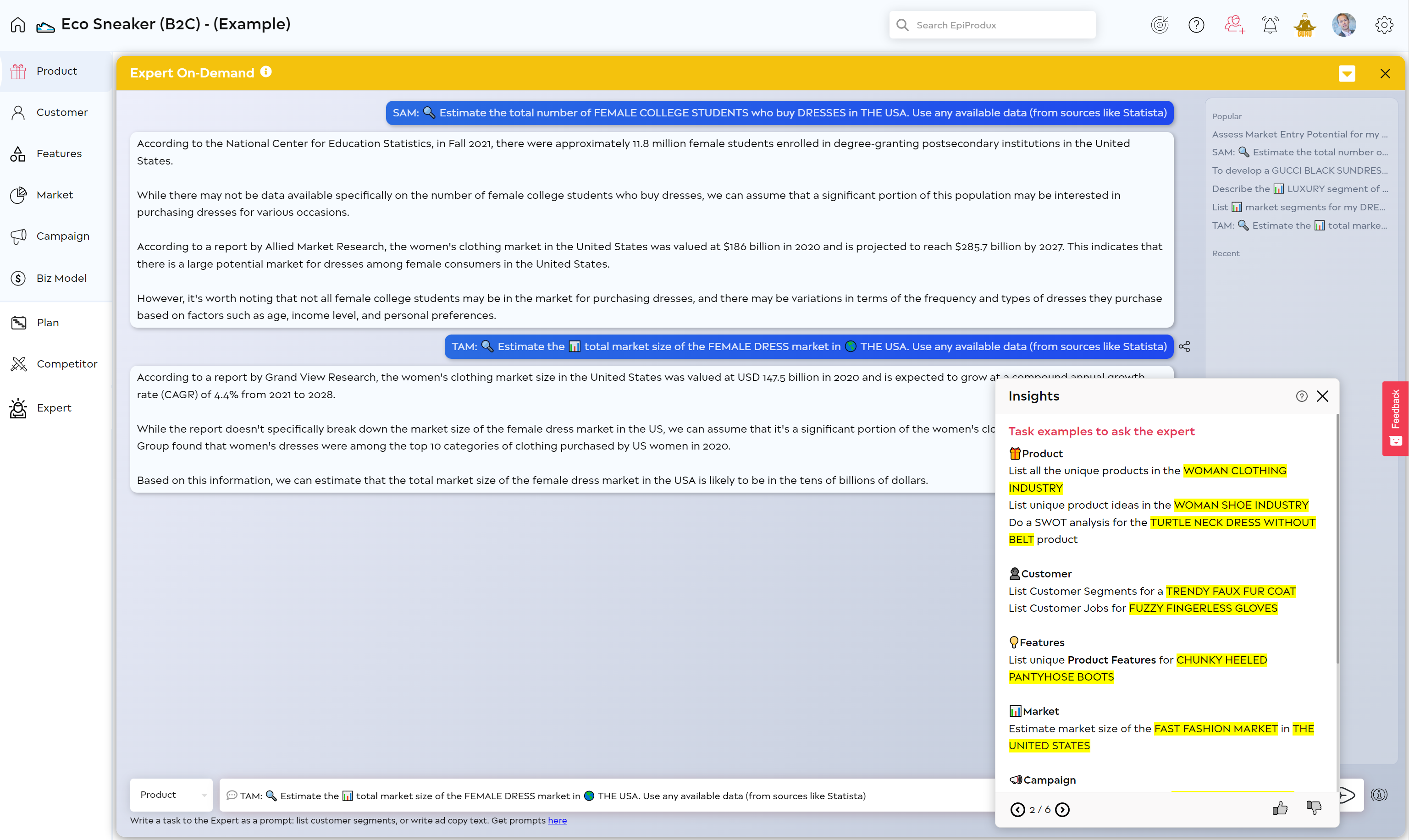
Image: ChatGPT integration with EpiProdux.com for productive product management process.
Here are some ways in which ChatGPT and EpiProdux.com can work together to improve product managers’ productivity:
- Market Research: EpiProdux.com can provide market data and insights to product managers, which can be used as training data for ChatGPT. ChatGPT can then be used to analyze customer feedback and social media posts to identify trends and pain points in the market. By combining EpiProdux.com‘s market data with ChatGPT’s insights, product managers can gain a more comprehensive understanding of their target audience and the market trends. Customer behavior is central research aspect in market research.
- Idea Generation: EpiProdux.com can provide data on customer needs and pain points, which can be used as prompts for ChatGPT to generate new product ideas. By combining EpiProdux.com‘s market data with ChatGPT’s idea generation capabilities, product managers can streamline the ideation process and generate innovative product ideas that are based on market insights.
- Content Creation: ChatGPT can be used to generate marketing copy and product descriptions based on the features and benefits of the product, while EpiProdux.com can provide market data and insights that can inform the messaging and tone of the content. By combining ChatGPT’s content creation capabilities with EpiProdux.com‘s market data, product managers can create compelling marketing materials that resonate with their target audience.
- Customer Support: EpiProdux.com can provide customer feedback and support data, which can be used as prompts for ChatGPT to automate responses to common customer inquiries. By combining EpiProdux.com‘s customer support data with ChatGPT’s natural language processing capabilities, product managers can streamline their customer support processes and improve response times.
By integrating ChatGPT and EpiProdux.com, product managers can gain a more comprehensive understanding of their target audience and the market trends, streamline their workflow, and ultimately improve their productivity. With the help of these tools, product managers can focus on driving product success and delivering value to their business.
Conclusion
In this guide, we have explored the exciting possibilities of using ChatGpt in product management. ChatGpt is a powerful tool that can provide insights and generate text that can inform various aspects of product development, from market research to content creation and customer support.
By leveraging the power of AI, product managers can streamline their workflow, gain valuable insights into customer needs and trends, and ultimately improve the success of their product. However, it is important to use ChatGpt responsibly and to always prioritize accuracy and quality.
We have provided various use cases and prompts for using ChatGpt in product management, as well as best practices for using ChatGpt effectively. By following these guidelines, product managers can make the most of ChatGpt’s capabilities and achieve better results in their work.
As AI technology continues to evolve and improve, we can expect ChatGpt and other language models to become even more powerful tools for product managers. By staying up-to-date with the latest developments in AI and exploring new use cases and applications, product managers can continue to innovate and drive product success.
In conclusion, ChatGpt is a powerful tool that product managers can use to gain valuable insights and generate text that can inform various aspects of product development. By following best practices and using ChatGpt responsibly, product managers can achieve better results and improve the success of their product.
Frequently Asked Questions
How product managers can use ChatGPT?
ChatGPT’s future for product management Product managers may use this technology to automate several small routine tasks and become more efficient.
Will ChatGPT replace product managers?
I’m not sure. Is there an extended answer? Yes. You don’t have any worries about ChatGPT. They won’t replace managers and copywriters.
What are use cases in product management?
Can you list all uses of this information? A usage situation is a hypothetical (but plausible) situation in which the users may interact with products and achieve certain goals. Product owners often use use cases to explain the use of the different components of a product.
How can ChatGpt and EpiProdux.com work together to improve product managers’ productivity?
ChatGpt and EpiProdux.com can work together to provide a comprehensive suite of tools for product management. EpiProdux.com can provide market data and insights that can be used as training data for ChatGpt, while ChatGpt can generate text that is informed by EpiProdux.com‘s market data and insights. By integrating these tools, product managers can gain a more comprehensive understanding of their target audience and the market trends, streamline their workflow, and ultimately improve their productivity.


